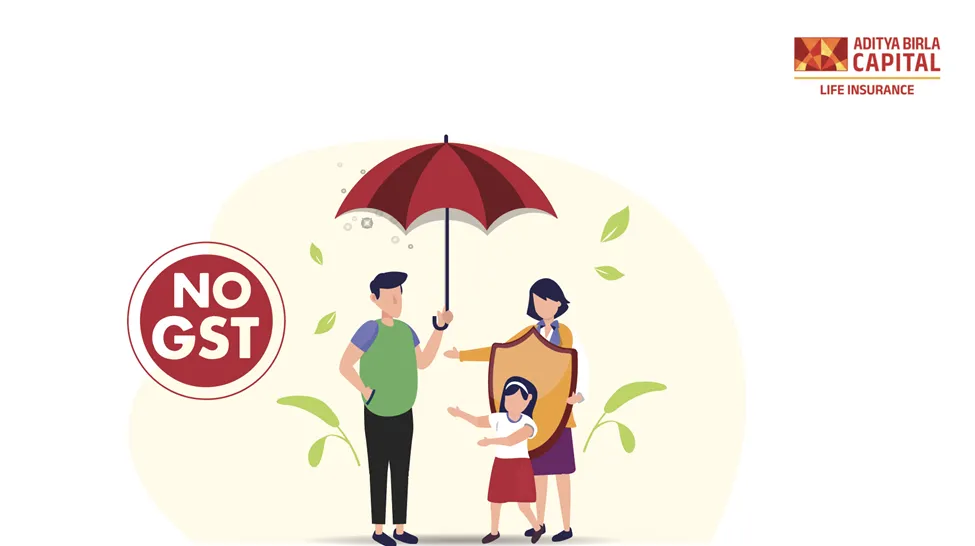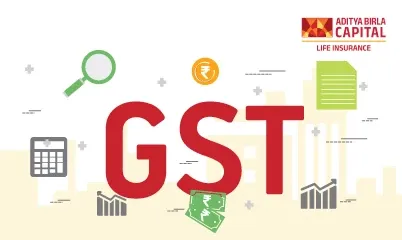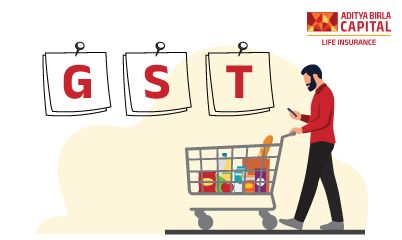For many Indian families, buying insurance has always been an emotional and financial balancing act. On one hand, there’s the peace of mind that comes with knowing your family is secure. On the other, there’s the added burden of taxes and rising living costs that make even basic financial protection feel expensive.
That’s why the GST removal on health and life insurance, announced in September 2025, marks a historic milestone. From 22 September 2025, premiums on both life and health insurance are completely GST-free.
It’s not just a change in tax policy. It’s a powerful statement, that financial protection is not a luxury, but a necessity that every Indian should be able to afford.
Understanding the Reform: What Does GST Removal Mean?
Until recently, all insurance policies were subject to 18% Goods and Services Tax (GST). That meant if your life insurance premium was ₹20,000, you actually paid ₹23,600 after adding tax. The same applied to health insurance, where families ended up paying thousands more every year.
Now, with the removal of GST, premiums for both life and health insurance are completely tax-free. You pay only the base amount, no additional tax, no complex calculations.
|
Type of Policy
|
Earlier (with 18% GST)
|
Now (0% GST)
|
|
Life Insurance
|
₹10,000 + ₹1,800 GST
|
₹10,000 flat
|
|
Health Insurance
|
₹25,000 + ₹4,500 GST
|
₹25,000 flat
|
|
Add-on Riders
|
₹5,000 + ₹900 GST
|
₹5,000 flat
|
For households managing multiple covers, this simple change can translate into significant savings year after year.
Why the Government Removed GST on Insurance
The reform, approved at the 56th GST Council Meeting, came after years of discussion around affordability and accessibility. The reasons behind it were clear and urgent.
Low Insurance Penetration
Despite being one of the fastest-growing economies, India’s insurance penetration remains below 5%. High costs, including taxes, discouraged people from purchasing protection policies. The GST removal directly tackles this issue.
Rising Cost of Living
Medical expenses and daily living costs have climbed steadily. Removing GST makes health and life insurance more affordable, helping families manage risks without stretching their budgets.
Universal Protection Vision
The government’s goal of “Insurance for All by 2047” depends on ensuring that cost is no longer a barrier. This reform is a crucial step in that direction.
Economic Inclusivity
By removing taxes on essential financial products, the government is sending a strong message: protection and healthcare are rights, not privileges.
How the GST Removal Impacts Life Insurance
Premiums Become More Affordable
Whether you have a term plan, endowment policy, ULIP, or whole-life cover, your premium is now 18% lower than before. This reduction can make a major difference, especially in long-term plans spanning decades.
Higher Coverage at the Same Cost
If you had a budget of ₹15,000 for your policy, that entire amount now goes into coverage, not taxes. This means you can afford a higher sum assured for the same annual outlay.
Better Returns on Savings Plans
For savings-linked plans like endowment or ULIP policies, a greater share of your premium now contributes directly to your investment or guaranteed# benefit, improving maturity outcomes.
Easier Renewals
Lower renewal costs mean fewer lapsed policies and more families staying continuously protected.
How the GST Removal Impacts Health Insurance
Lower Premiums for Every Household
A family floater plan that earlier cost ₹35,400 (including GST) now costs only ₹30,000. That ₹5,400 annual saving can easily fund preventive check-ups or medicines.
More Families Can Buy Coverage
Affordable premiums bring millions of new households, especially in Tier 2 and Tier 3 cities, under the insurance umbrella for the first time.
Encouragement for Preventive Health
Modern health policies offer preventive benefits like check-ups and vaccinations. When premiums fall, families are more likely to stay insured and use these benefits regularly.
Easier Access for Senior Citizens
Older individuals face higher premiums due to age-based risk. The GST removal gives them immediate relief, helping them maintain or increase coverage in their retirement years.
Who Benefits Most from This Reform
Middle-Class Families
For working families balancing EMIs, school fees, and monthly expenses, this reform eases financial pressure. Even small savings on premiums translate into greater peace of mind.
Young Professionals
Early-career earners now have one less reason to postpone buying insurance. Affordable premiums make it easier to start protection early and lock in lifelong benefits.
Senior Citizens
Older adults with high-premium health or pension plans benefit the most, as their annual tax savings are significantly higher.
Self-Employed and Small Business Owners
Those without corporate coverage can now access quality insurance without feeling the pinch of additional taxes.
Employers
Companies offering group life or health insurance will also save on costs, allowing them to extend broader benefits to their employees.
Broader Economic Impact of GST Removal
The ripple effects go far beyond individual households.
- Higher Insurance Penetration: Affordable premiums drive more policy sales, especially in rural and semi-urban regions.
- Boost to Long-Term Savings: Life insurance channels household savings into productive investments, supporting national growth.
- Reduced Financial Vulnerability: More insured citizens means fewer families pushed into debt by emergencies.
- Stable Insurance Sector: Greater participation improves risk distribution, stabilising claim ratios and industry profitability.
- Employment Opportunities: As insurers expand, job creation in sales, underwriting, and customer service will rise.
How the Reform Reflects India’s Changing Financial Mindset
For decades, financial protection was often treated as optional, something to consider only after achieving other goals. The GST removal on health and life insurance changes that perception.
It reinforces three important shifts:
- Insurance as a Necessity: Protection is now seen as a basic financial responsibility, not an additional expense.
- Affordability for All: The reform ensures no one feels priced out of essential coverage.
- Simplification and Trust: Transparent, tax-free pricing builds consumer confidence in financial planning.
Practical Example: The Real-World Savings
Consider this example:
A family of four holds:
Before GST Removal:
Total premium = ₹40,000 + ₹7,200 (GST) = ₹47,200
After GST Removal:
Total premium = ₹40,000 flat
That’s ₹7,200 saved each year, or ₹72,000 saved over 10 years, without any change in coverage or benefits.
For many Indian households, those savings can pay for a child’s school fees, a vacation, or even an investment SIP.
Impact on Existing Policyholders
If you already have a life or health insurance policy, here’s how the reform affects you directly:
- Automatic Premium Adjustment: Insurers will automatically remove GST from premiums upon renewal after 22 September 2025.
- No Action Needed: You don’t need to re-apply or sign fresh documents, the change applies universally.
- Better Value on Long-Term Plans: For multi-year policies, renewals will now cost less, increasing your effective returns.
- Freedom to Upgrade: You can use the savings to increase your coverage or add useful riders.
Riders and Add-Ons Also Become Cheaper
Riders, add-on covers that enhance your protection, were previously taxed at 18%. Post-reform, these are GST-free too.
This means benefits like:
- Critical Illness Cover
- Accidental Death Benefit
- Waiver of Premium
- Hospital Cash Allowance
- Income Benefit on Disability
can now be added at a lower cost, making comprehensive protection easier to achieve within your budget.
Simplifying Renewals and Claims
GST removal also simplifies the overall customer experience:
- Premium invoices are easier to understand, with no tax breakdown.
- Claim processing for policies with combined health and life benefits becomes simpler.
- Insurers can issue clearer policy documents with uniform pricing.
In short, the entire process of buying, renewing, or claiming insurance has become smoother and more transparent.
The Reform’s Alignment with National Priorities
The GST removal supports several ongoing government initiatives:
- Insurance for All by 2047: Expanding protection coverage across the country.
- Ayushman Bharat and Health for All: Strengthening private participation in healthcare protection.
- Ease of Doing Business: Reducing compliance burdens for insurers and policyholders.
- Financial Inclusion: Bringing every income group into formal financial security systems.
It’s a unified effort toward building a more resilient, financially aware India.
How Insurers Are Adapting
Insurance companies are working rapidly to pass on the benefits of this reform to customers.
They are:
- Revising premium rates and removing GST components.
- Updating policy documents and digital tools to reflect new rates.
- Training advisors to explain the reform’s benefits clearly.
- Launching awareness campaigns to reach new audiences.
This ensures that the impact of the reform is not just on paper but felt across every household.
How You Can Make the Most of This Change
Whether you’re buying a policy for the first time or already covered, here are smart steps to maximise your benefit:
-
Check Your Renewal Dates: Confirm that your next payment reflects the GST-free premium.
-
Review Coverage: Use savings to upgrade your sum assured or add riders.
-
Combine Health and Life Protection: Create a comprehensive safety net for your family.
-
Start a Long-Term Plan: Lower costs make savings and investment-linked policies more attractive.
-
Encourage Family Members: Spread awareness, your parents, spouse, and siblings can all benefit.
From 18% to 0%: A Shift in Perspective
|
Aspect
|
Before September 2025
|
After September 2025
|
|
GST on Premiums
|
18%
|
0%
|
|
Insurance Cost
|
High
|
Lower and affordable
|
|
Coverage Reach
|
Limited
|
Wider across demographics
|
|
Public Perception
|
Optional expense
|
Essential household protection
|
|
Policy Renewals
|
Declining
|
Stronger continuity and trust
|
This transformation marks the moment when insurance finally becomes a mainstream financial product, not an afterthought.
The Social Impact of GST Removal
Beyond numbers, this reform has a deeply human impact. It helps families feel safer, more confident, and more in control of their future.
- No more second-guessing whether you can afford protection.
- No more feeling that security comes with an extra cost.
- No more postponing insurance because “it’s too expensive right now.”
By making insurance tax-free, the government has empowered every Indian family to take their financial safety seriously.
Final Thoughts
The GST removal on health and life insurance is more than a tax change, it’s a national milestone.
It redefines how India views financial protection, turning it from a costly obligation into an affordable necessity.
For individuals, it means more savings and stronger coverage.
For insurers, it means a broader, more engaged customer base.
And for the country, it means progress toward a financially resilient future.
If you’ve been delaying buying or upgrading your policy, now is the best time to act.
Because with zero GST, the only thing growing is your family’s protection, not your premium.










